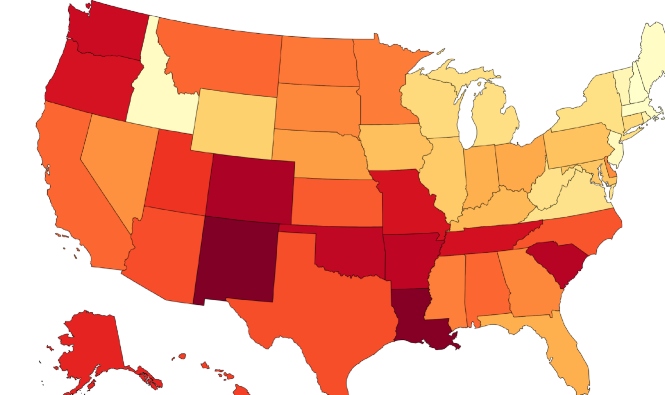The American legal landscape reflects a patchwork of state-level variations, shaped by demographics, geography, culture, and legislative priorities. While all fifty states recognize and prosecute the full spectrum of crimes, patterns emerge that reveal which offenses are most prevalent in certain jurisdictions.
Understanding these trends not only informs policymakers but also helps legal practitioners, scholars, and citizens alike grasp the broader picture of criminal law enforcement in the United States.
This article provides a comprehensive overview of the most common crimes across U.S. states, grounded in crime statistics, judicial data, and socio-legal trends.
National Overview: The Baseline of Crime in America
Before examining individual states, it is worth noting that nationally, the most frequently prosecuted crimes fall into a few broad categories:
- Property Crimes – Theft, burglary, larceny, and vandalism continue to dominate crime reports.
- Drug Offenses – Possession, distribution, and trafficking of controlled substances remain among the most charged offenses, though marijuana reform has shifted the legal landscape in many states.
- Violent Crimes – Assault, robbery, and homicide vary widely by region but consistently rank among the leading causes of incarceration.
- DUI/DWI Offenses – Driving under the influence is prosecuted in every state, reflecting both public safety concerns and strict statutory regimes.
Click here for FBI’s updates on Crimes in the United States.
Common Crimes by State
Alabama
- Most Common Offense: Property crimes, particularly theft and burglary.
- Notable Trend: High rates of violent crime relative to national averages, concentrated in urban areas like Birmingham and Montgomery.
Alaska
- Most Common Offense: Domestic violence and sexual assault, reflecting long-standing social and geographic challenges.
- Notable Trend: Alaska consistently reports the highest per-capita rate of sexual violence in the nation.
Arizona
- Most Common Offense: Drug trafficking and smuggling, influenced by proximity to the U.S.-Mexico border.
- Notable Trend: Property crimes in Phoenix and Tucson remain above national averages.
California
- Most Common Offense: Property crimes (larceny and burglary).
- Notable Trend: Significant drug-related offenses and gang activity in major metropolitan areas.
Florida
- Most Common Offense: Fraud-related crimes, including identity theft and elder exploitation.
- Notable Trend: Miami is often cited as a hub for complex financial crimes.
Georgia
- Most Common Offense: Aggravated assault and property crime.
- Notable Trend: Atlanta’s metropolitan area sees high rates of both violent and property crimes.
Illinois
- Most Common Offense: Gun-related offenses and violent crime.
- Notable Trend: Chicago’s homicide rate drives national discussions on gun violence.
Louisiana
- Most Common Offense: Violent crime, including homicide, aggravated assault, and armed robbery.
- Notable Trend: Louisiana consistently reports one of the highest per-capita incarceration rates in the country.
Michigan
- Most Common Offense: Larceny and auto theft.
- Notable Trend: Detroit remains a national focal point for car-related crimes.
New Mexico
- Most Common Offense: Property crime, particularly burglary.
- Notable Trend: New Mexico has one of the highest violent crime rates in the nation.
New York
- Most Common Offense: Larceny and petit theft.
- Notable Trend: While violent crime has decreased in New York City since the 1990s, fraud and financial crimes are prevalent.
Texas
- Most Common Offense: Drug-related offenses and DUI.
- Notable Trend: Border counties experience higher incidences of trafficking and smuggling.
Washington, D.C.
- Most Common Offense: Robbery and motor vehicle theft.
- Notable Trend: Gun-related crimes remain a persistent concern.
Regional Trends
- Southern States (Louisiana, Mississippi, Alabama, Georgia): Higher violent crime and homicide rates.
- Western States (California, Arizona, Nevada, New Mexico): Elevated property crimes and drug offenses.
- Midwestern States (Illinois, Michigan, Ohio): Gun-related crimes and auto theft dominate.
- Northeastern States (New York, New Jersey, Massachusetts): Financial crimes, fraud, and larceny rank high.
Legal Implications
These trends underscore the importance of state-level policymaking in addressing criminal behavior. For instance:
- Sentencing: States with high drug offenses often balance between punitive measures and treatment-based diversion programs.
- Gun Laws: Jurisdictions grappling with firearm crimes face constitutional challenges in regulating Second Amendment rights while ensuring public safety.
- Fraud Prevention: States like Florida and New York highlight the growing legal focus on cybercrime and elder fraud.
Conclusion
The distribution of common crimes across states illustrates how local realities shape the enforcement of law. While theft, drug crimes, and violent offenses are universal, their prevalence varies dramatically, offering insight into the complex interplay between law, society, and geography.
Legal professionals, policymakers, and communities benefit from recognizing these distinctions in shaping future responses to crime.

